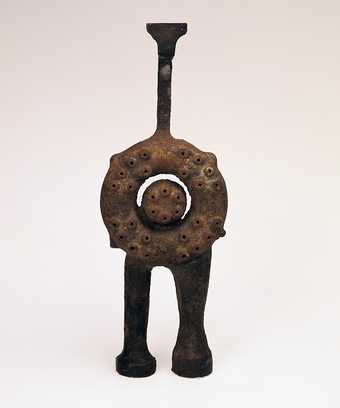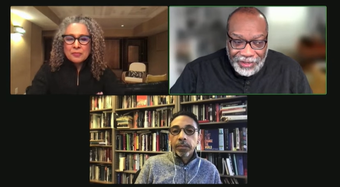In 1935 the poet Georges Henein, one of the founders of the Egyptian surrealist group Art et Liberté, published the article ‘Hot Jazz’ in the Cairo-based revue Un Effort. In it Henein described jazz as a ‘direct assault that engages your senses and pulls them into an exquisite and furious embrace with the sound’.1 In an attempt to demystify the process of jazz composition and move beyond the understanding of jazz as an automatic and physical surrender to sound, Henein distinguished between ‘arrested’ and ‘continuous’ creation. The former denoted a work that is ‘to remain immutable’, to be reconstructed in subsequent performances exactly as the composer intended.2 The latter marked the openness of a work’s original form to being distorted, folded and multiplied. For Henein, ‘continuous’ creation could be improvised on by new artists who would fuse their own personality with that of the composer’s, ‘instead of faithfully keeping [the work] as it is’.3 As such, perpetual and dialogical creation was essential to jazz composition.
Henein’s text points to the critical relationship between source and translation and their relationship to authenticity and power in authorship. The ‘translated’ is often understood as a belated imitation that inherits only an echo of the original, or that meets the original with an entirely new form. Such notions of translation have been central to surrealism, prompting questions about the movement’s historical integrity, as seen in the recent charting of surrealism’s international presence by curators and art historians. Surrealist thought and production beyond Paris often had substantively different configurations and aims and was perceived by early commentators as untranslatable. What does this mean for surrealism as a whole, and how can we make sense of it with the theoretical tools at our disposal?
Since its inception in France, surrealist exhibitions were as devoted to the display of new work as they were to the gathering of minds that interpreted and engaged with the movement’s discourse. This was evidenced by the large catalogues produced for these events. For example, the exhibition Le Surréalisme en 1947 at Galerie Maeght was the first to take place in Paris after the Second World War, and brought together artists from twenty-four countries across the globe. Its catalogue included illustrations of the works on show, as well as previously unpublished artworks, original poems and contributions from scholars and critics of the day.4 It attempted to articulate the movement’s fast-paced intellectual evolution and geographical expansion. The exhibition Surrealism Beyond Borders at the Metropolitan Museum of Art and Tate Modern is the first show in more recent years to take a similarly collective and international stance.
The symposium ‘Surrealism Beyond Borders’ addressed some of the pressing questions around translation and internationalism that were raised by the exhibition. Arranged in four sessions across two days, the event hosted an interdisciplinary cohort of speakers that included curators and art historians, scholars of comparative literature and anthropology, and contemporary art practitioners. In convening this programme around critical questions of geography and chronology, the discussions allowed for a renewed and cross-disciplinary look at surrealism during a pivotal moment in the movement’s history.
The exhibition’s co-curators, Stephanie d’Alessandro and Matthew Gale, began by expressing how the symposium supported the exhibition’s aims, which were to reconsider the surrealist movement by exploring the various geographies in which it took hold and to identify the factors that led to the erasure of diverse art histories.5 The exhibition’s rationale owed much to the legacy of postcolonial theory and the symposium appeared to be sensitively framed around notions of the ‘transnational’, the ‘transhistorical’ and the ‘global’.6 This turn towards the global in art history has compelled the field to reconsider its role, its history and its theoretical shortcomings.7 Fittingly, then, the symposium’s opening session explored the geographic expansion of the surrealist movement. Entitled ‘Surrealism and Place’, it probed the boundaries of ‘place’ beyond the notion of a body in a physical location.

Clockwise from top left: Joan Kee, Krzysztof Fijalkowski, Talinn Grigor, fahima ife and Lori Cole during the panel discussion ‘Surrealism and Place’
In this session, the art historian Krzysztof Fijalkowski addressed the ways in which surrealist artists approached cartography, a scientific discipline that hinges on accuracy, legibility and adherence to convention. By mapping the illegible, displaced and ‘imagined border zones’ developed by surrealist artists, Fijalkowski pointed to the political stakes inherent in these articulations of space. He discussed the 1978 collage Destruction of a Map by exiled Kurdish-Iraqi surrealist artist and writer Haifa Zangana. A member of the Iraqi Communist Party in the 1970s, Zangana participated in activist opposition to the ruling Ba’ath Party and faced six months of imprisonment and torture at Abu Ghraib prison.8 Destruction of a Map is a collage in grisaille – a method of painting in grey monochrome – that shows men in Western classical attire violently attacking a map of the Middle East that charts the imperial expansion across the region by ancient Greek king Alexander the Great. The work grapples with borders as weapons of nationalist and imperialist ideology, and denounces the violence that these ideologies visit upon those trapped under repressive regimes or forced into exile.

Pablo Picasso
The Venus of Gas 1945
Iron
250 x 90 x 40 mm
Private collection
The editor and publisher Mark Polizzotti then discussed the exhibition Surrealism and the Object which took place at the Centre Pompidou in Paris in 2013. It featured contemporary responses to surrealist objects by artists such as Mona Hatoum and Cindy Sherman. Polizzotti argued that these works lacked the suggestive power of their predecessors, stating that ‘it was as if the contemporary artists had studied their surrealist catechism … taken all the right notes and parroted it back perfectly with the result that the message became ever more diluted’. The fear that a continuous and collaborative creation could diminish the potency of the surrealist message is in part due to the historically contingent configuration of the French surrealist group. This in turn enables a perpetual regression towards a perceived ‘origin’ which regards other surrealist expressions as erroneous copies. According to Polizzotti, the further back one follows the chain of influences, the more emotionally persuasive the work becomes. To this effect, he offered as an example Picasso’s The Venus of Gas 1945 (private collection), a work that can hardly be considered marginal since it was one of the most valuable objects in the Pompidou exhibition. In light of the symposium’s response to issues of art historical erasure, as well as its demands for more inclusive and expansive narratives, this contribution felt strangely out of place.
A more robust investment in expanding the established geography of surrealism was provided by Lori Cole and Talinn Grigor in their respective presentations, also in the ‘Surrealism and Place’ session. Their case studies highlighted discord in the translation of surrealism beyond Europe. Cole presented a history of the circulation of surrealism by means of journals and exhibitions in Latin America, exposing them as ‘portable sites for collaborations and exchange’. These contributed to the notion of surrealism as a form of ‘Esperanto’ – a collectively authored language which can be freely adapted by its participants. In her talk, Grigor discussed the activities of the Iranian Fighting Cock (Khorus Jangi) group, established in the late 1940s, whose surrealist production contributed to the systematic challenging of theoretical and existential certainties. In exploring issues such as the essential integrity of the human, Khorus Jangi’s work provided a counter to state-mandated artistic concerns. Their deliberate untranslatability in the surrealist canon, Grigor argued, similarly challenged the unity of surrealism within and beyond Europe’s institutional structures.

Clockwise from top left: Zita Cristina Nunes, Fred Moten and Robin D.G. Kelley during the panel discussion ‘On Black, Brown and Beige’
The systematic questioning of the absence of histories like that of Khorus Jangi from ‘official’ surrealist accounts formed an overarching concern for the rest of the symposium. The panel dedicated to the 2009 publication Black, Brown and Beige: Surrealist Writings from Africa and the Diaspora, edited by Franklin Rosemont and Robin D.G. Kelley, was particularly invested in understanding the logic behind historical exclusions. While the three panellists – the scholars Kelley, Zita Cristina Nunes and Fred Moten – praised the overall aims of the book, the format of the publication had proved frustrating. The anthology served as a collection of texts and poems by artists of colour previously missing from surrealist histories. It was deemed inclusive of some artists but still exclusive of others. Moreover, as Kelley pointed out, many of the figures included did not necessarily identify as surrealist but rather acted as agents of diffusion with wider revolutionary aims. The book, they concluded, functioned as a heuristic exercise in continuous creation: it was intended primarily as a provocation that could open the door to a more symphonic and concerted approach to surrealist history. Yet for Kelley, the print medium was inadequate in capturing the sonic and oral qualities of Black surrealist praxis, which involved both music and spoken poetry.
Addressing the silence of print, Moten played two pieces of music by Black artists that were composed forty years apart: George Clinton’s 1986 ‘Mixmaster Suite’,9 which montaged elements of R&B with funk and dance music, and Klein’s 2021 ‘Roc’,10 which mingled orchestral arrangements with a single, dissonant piano. These were played alongside verses by the surrealist poet Lucie Thesée, which Moten read aloud. Echoing Henein’s reading of jazz as non-linear creation, Moten articulated a pattern of aural resonance between the two composers’ approaches to constructing sound, rooted in ‘repetition and interruption’. In doing so, he reflected on the montagic, transtemporal quality of surrealism which accommodates both new and old, and gives rise to novel and marvellous artistic expression. Recursion, interruption, repetition and variation are understood here as disruptions to the linear narrative of progress associated with modernity which produces dichotomies such as ‘centre and periphery’.11 Indeed, the assumption of a historical and geographical centre of cultural activity in the modernist period led to the marginalisation of certain art histories. For Moten, reconsidering the work of Black surrealists through the lens of improvisation as a practice of critical retention and reconfiguration, or indeed ‘continuous creation’, is foundational to understanding modernism as a global and plural phenomenon.

Torkwase Dyson
Plantationocene 2019
Acrylic, graphite, brass, wood and ink on canvas
Diameter: 2489.2 mm
Pace Gallery, New York
This discussion resonated back to writer fahima ife’s spoken poetry performance in the first panel, where they read an excerpt from their book Our Propulsion was Flowers.12 This was accompanied by the ethereal and dissonant sound of Nala Sinephro’s ‘Space 8’ (2021).13 ife’s poetry formed an instance of surrealist translation in contemporary practice by means of an ekphrastic reading – a form of poetic description – of Torkwase Dyson’s 2019 work Plantationocene (fig.2). They interwove the history of the murder of African-American teenager Eugene Williams, who was killed for accidentally swimming in ‘white waters’ in Lake Michigan in 1919, with the recent displacement of low-income communities of colour in south-west Atlanta. In ife’s work, water and trees are conjured as borders of inclusion and segregation. By engaging a surrealist methodology to articulate the politics of ecology, ife invokes new spaces for Black liberation.
The relevance of such contemporary expressions prompted the concluding session of the symposium to ask: how can we account, in the present moment, for surrealism as both a live and a global entity? A compelling model came from the visual studies scholar Michael Stone-Richards, who challenged ‘the idea of Europe’ as a mode of thinking and of experiencing history and time, one whose putative authority disavows alternative accounts of modernity. Similarly, art historian Partha Mitter addressed the temporality that the discourse of centre and periphery engenders. Crucially, he exposed the double standard that identifies modern productions of ‘peripheries’ as having a purely local spirit. Indeed, Mitter argued that the role of the Euro-American avant-garde’s emancipatory thrust in providing inspiration to colonised ‘peripheries’ should not be understated. Nonetheless, Mitter and Stone-Richards both concluded that new art historical models are needed for comprehending the extent to which modernism was a product of cultural reciprocity, of recursion and interruption, both geographically and temporally.
The symposium reflected this final theoretical uncertainty, oscillating between two paths. The first path was an anthological approach, seeking to herd a plurality of voices under a revised master narrative of transnational surrealism that can make sense of the divergence at the core of these encounters. The second was a symphonic approach, inviting difference, dissonance and repetition as valuable frameworks for historical reparations and disciplinary shifts. The question of whether the incommensurability of surrealist expression could be bridged or simply taken at face value remained unanswered. Yet the speakers found common ground in drawing attention to the elasticity and plasticity of borders – whether they be geographical, temporal or theoretical. This made space for new contributions to enter surrealist art history and for new research and thinking to emerge.
